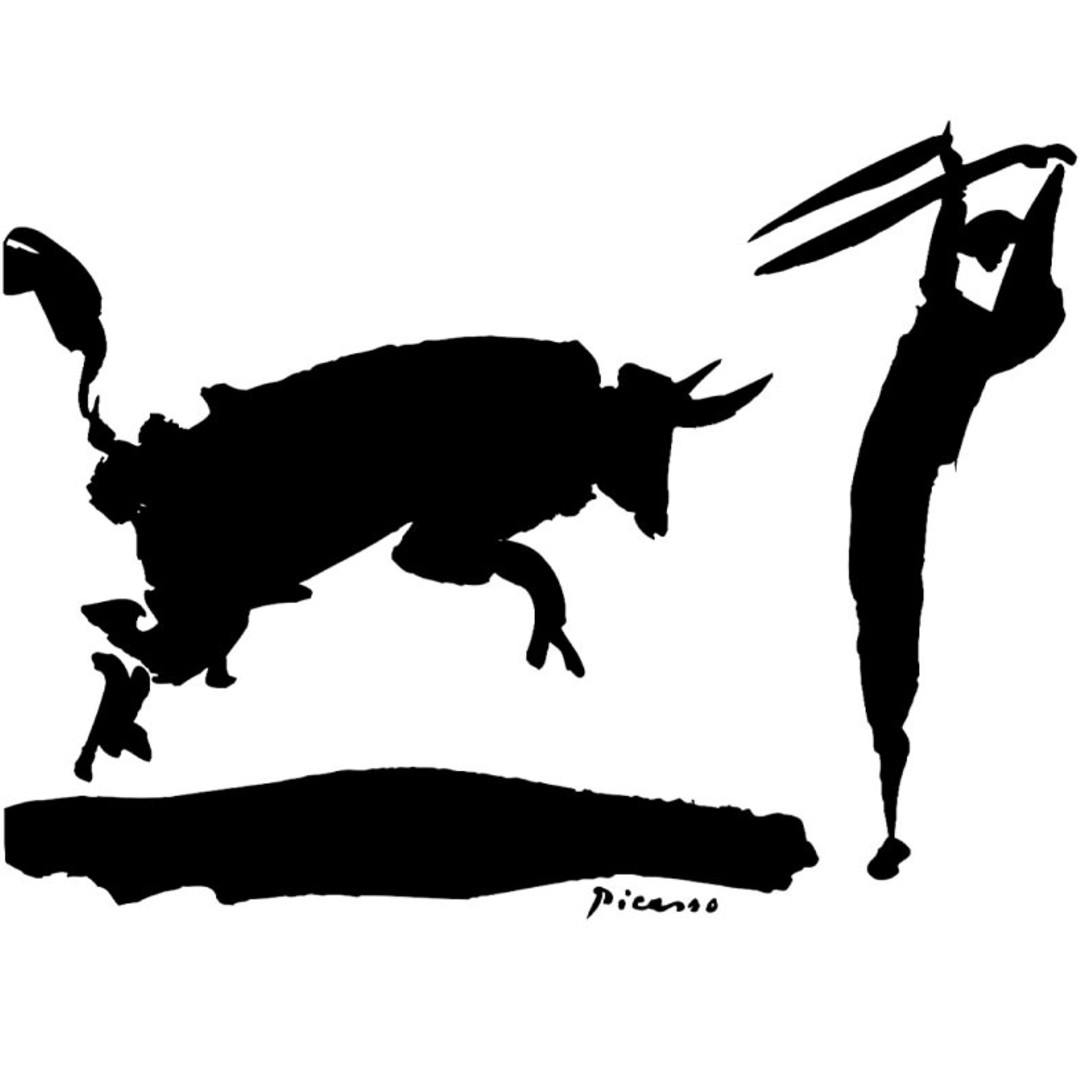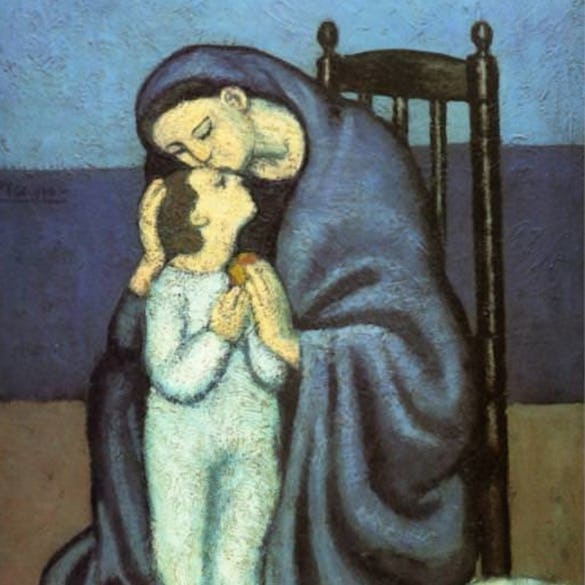There’s a simple piece of cloth that binds legends Georges St-Pierre and Pablo Picasso: Canvas. And although each has lived in different times and held contrasting professions, each has displayed his own artistic spin on canvas.
Every treasure derived from Picasso’s gifted paint strokes convey a range of possibilities. From the sweetness between a mother and child to his Portrait of Ambroise Vollard featuring an angular complexity. Meanwhile Bullfight III is pure simplicity. In the end, Picasso’s versatility has made his artwork stand the test of time, enduring the changing tides of the art world.
The same holds true for Georges St-Pierre. When he steps onto the canvas floor of a cage, surrounded by throngs of screaming fans and an opponent more than willing to place an end to his legacy, St-Pierre’s work is nothing shy of masterful. He’s shown comfort in the capacity to change styles mid-fight, either creating angles to avoid his opponents or punish them.
The ability to be creative is important for both painter and fighter.

St-Pierre’s ascent to the top of the Mixed Martial Arts sphere has oftentimes mirrored the same simplicity of Picasso’s Bullfight III. In that uncomplicated piece of art, lies a skillset most strive to achieve. His ability to perform at a level so high, makes something extremely difficult seem exceedingly easy to spectators.
Peeling back the layers of his accomplishments reveals what’s at the heart of St-Pierre’s success: Versatility.
“Versatility for a mixed martial arts fighter is very important,” St. Pierre told Hayabusa shortly after a training session at Wild Card Boxing Club in Los Angeles. “It’s important to be creative. In order to be creative you need to be able to go get different tools. … In order to do that, you need to get out of your comfort zone.”
His open-minded approach to training and life shows he’s just fine with shunning the proverbial comfort zone. Being comfortable and unchallenged just isn’t St-Pierre’s way. In preparing for his bouts — or even to stay in great shape — it’s not out of the ordinary to see GSP in a swimming pool using water resistance to strengthen his body. Nor is he a stranger to incorporating plyometrics into his fitness routine while at a gymnastics facility.

There’s plenty of footage of the world champion hoisting his body on the parallel bars or somersaulting into thick padding. His goal is to improve his overall strength, explosiveness, stability in his core, and gain a level of body control most of his opponents overlook. In his view, gymnasts are the best athletes around.
In addition to honing his skills as a Jiu Jitsu black belt, often times St-Pierre harkens back to his background as a Kyokushin Karate black belt. It’s a martial art he was introduced to at the age of 7 after being bullied in school.

If they’ve got the talent, you’ve just got to bring it out of them
- Freddie Roach

Embracing a versatile training regimen and mindset has served as a foundation on which St. Pierre won the UFC’s welterweight belt twice, was crowned the middleweight champion and defended his titles nine consecutive bouts between 2008 and 2013. During his MMA career, GSP tallied a 26-2 record with eight knockouts and six submissions.
Neither champion status nor being dubbed one of the world’s all-time greatest mixed martial artists deterred St-Pierre from seeking knowledge and then mastering those new skills. Instead of adopting complacency, he sought out legendary boxing coach Freddie Roach to take his boxing skills to an elite level, adding yet another tool to his artistry.
“If they’ve got the talent, you’ve just got to bring it out of them and make them use it the most useful way you can,” Roach said about training fighters of different skill levels. “Everyone’s a little bit different, of course.”

Considering Roach has trained iconic boxers Mike Tyson, Bernard Hopkins, and Manny Pacquiao, St-Pierre, even with his championship credentials, felt insecure upon his first session with Roach. But, again, it was a chance to step away from comfort and embrace something different.
“Versatility is also the capacity to adapt yourself to become the perfect nemesis to solve a problem,” St-Pierre said. “In mixed martial arts it’s very important and in your life it’s very important, too. If you’re only good at one thing and you can’t perform other tasks, you’ll be very limited in what you can do and what you can achieve.”
The partnership has yielded plenty of success. Roach became St-Pierre’s boxing trainer in 2010, guiding his pupil in the lead up to six different bouts. In St-Pierre’s November 2017 win against Michael Bisping, Roach, who has trained other mixed martial artists, was in the corner for the first time in an MMA fight. St-Pierre won, submitting Bisping in the third round and collecting the middleweight title.
“I love training with Freddie,” St-Pierre said. “It keeps me on the edge, it keeps me humble. Every time I work out with Freddie I learn something new.”
During that particular training camp, St-Pierre said he flew in fighters to Montreal from all over the world, including Spain, in an effort to face people he was unfamiliar with. It was another opportunity to place himself in an uncomfortable environment, so if that time came against Bisping, he would know how to handle it.
“And this is very important to recreate that in your everyday training camp environment. Most guys are not willing to do that,” he said. “They want to stay with the same people so when they go into the fight and they have butterflies, they’re not used to dealing with it. The key is to have the butterflies, but being able to make them fly in formation, so to speak. And there’s only one way to achieve that. Its to try and recreate the same situation in your everyday environment.”

Everybody has a fighter’s spirit. I think it’s ingrained in our instincts.
- Georges St-Pierre

This isn’t just the mindset of a professional fighter. It applies to everyday fighters. The skills gained from being versatile and placing yourself in an uncomfortable position can still bring out that spirit of a fighter, even if there are no plans to enter a ring and go toe-to-toe with a glove-wearing opponent.
“Everybody has a fighter’s spirit,” St-Pierre said. “The proof of that is I can put any human being in a situation where they will be forced to fight. Either to defend themselves or to defend someone he loves. Even, for example, my mother, who is the nicest human being I know, if I would put her, when we were younger, in a situation that she had to defend her babies in order to survive, she would have fought for us.
“So fighting is something that’s natural. Everybody has a fighter’s spirit. I think it’s ingrained in our instincts. Some people chose to use it more than others, but I think there’s different ways to be a fighter. If you’re a lawyer, you fight for a cause in court. You can fight when you go and negotiate a raise to your boss. … there’s different ways of fighting.”
It’s all about being versatile.

Mother and Child: During what has been dubbed as Pablo Picasso’s Blue Period (1901-1904), in which he used blue and blue-green hues, this piece displays a loving relationship between a mother and child. The artwork was inspired by Vincent Van Gogh, who painted a series featuring his friend’s wife and child. According to historians, Picasso held Van Gogh in high esteem.
Photo Provided by: www.PabloPicasso.org

Bullfight III: This Pablo Picasso creation was drawn in February 1960 and depicts moments of a bullfight. Picasso produced 14 of these drawings using that theme, signing and numbering each one.
Photo Provided by: www.PabloPicasso.org

Portrait of Ambroise Vollard: Pablo Picasso painted this piece in 1910, depicting art dealer Ambroise Vollard. The oil-based portrait used angular, multi-hued pieces to construct Vollard's face, head and torso. This form of art, Cubism, is considered one of the most influential periods for European painters and those who created sculptures.
Photo Provided by: www.PabloPicasso.org





